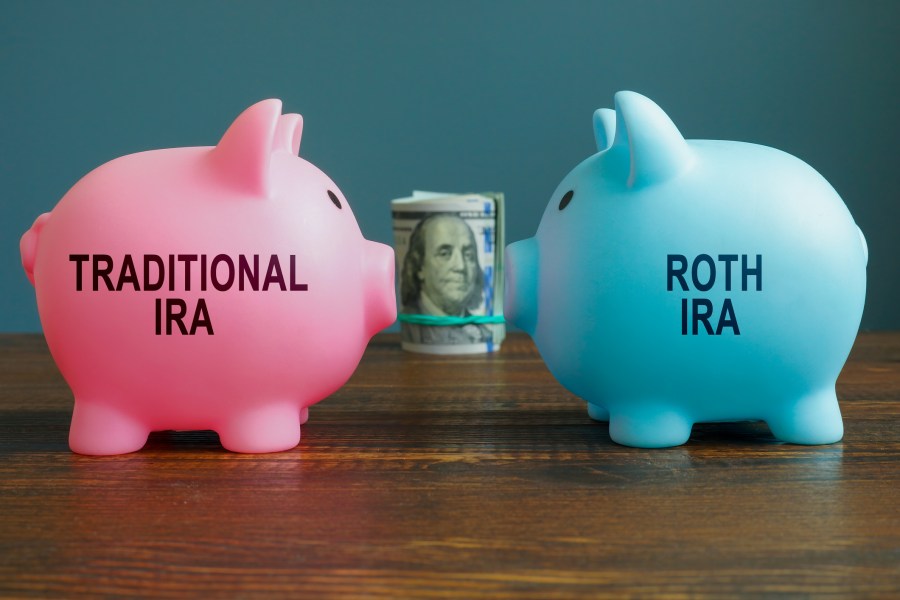
If you’re ready to boost your retirement savings, but aren’t sure where to begin, you can start by opening an individual retirement account (IRA). An IRA is a type of investment account intended to help investors prepare for their retirement. You can use an IRA as your primary retirement savings vehicle, or you may use it in conjunction with an employer-sponsored retirement account (like a 401(k)).
There are two types of IRAs: the traditional IRA and the Roth IRA. The best option for you depends on your current and future financial situation. Do you anticipate your income dropping or increasing when you retire? Do you want to ensure that you have access to this money when you retire? Or is this more of a rainy day fund you hope to leave to your beneficiaries? The answer to these questions will help you determine which type of account is right for you. Read on to learn more!
What’s the Difference Between a Roth and Traditional IRA?
When you contribute to a traditional IRA, you make the contributions with before-tax dollars. This means that your contributions are tax-deductible and will lower both your taxable income and overall tax obligation. However, in exchange for the ability to deduct your contributions, you must pay taxes on your withdrawals in retirement. Until you retire, your contributions and earnings continue to grow tax-free. You must begin taking withdrawals from your traditional IRA by 70.5 years of age. There is an option known as a non-deductible traditional IRA. It’s commonly used by investors who exceed the income restrictions associated with deductible traditional IRAs and Roth IRAs. You can’t deduct your contributions, and you do have to pay taxes on the income in retirement. Your contributions to a Roth IRA are made with after-tax dollars. You can’t deduct your Roth IRA contributions on your tax return, but when it’s time to use your savings in retirement, you won’t have to pay taxes on your withdrawals. There are no withdrawal requirements; if you don’t need the money, you’re free to leave it in the account and leave it to your beneficiaries.
What Type of IRA Should You Open

A traditional IRA is ideal if you think that you’ll be in a lower tax bracket in retirement. Since your current tax bracket is higher than your future tax bracket, it makes sense to take the income tax deduction now. If you believe that you’ll be in a higher tax bracket in retirement, a Roth IRA is a better option. It’s a smart choice to pay income taxes on the contributions now when you are in a lower tax bracket, versus paying taxes in retirement when your tax bracket is higher. Unfortunately, it’s difficult to accurately forecast your future tax situation, especially if you have a long time until you retire. If you’re in this situation, use your IRA to diversify the tax treatment of your retirement savings to mitigate your risk. For example, if you currently have a 401(k) (funded with pre-tax dollars), boost your savings with a Roth IRA. If you use Roth 401(k) to save for retirement, opening a traditional IRA would mix up the tax treatment of your retirement funds.
Are There Any Restrictions for Opening a Roth or Traditional IRA?
Both the traditional and Roth IRA have rules concerning your income. You can fund a traditional IRA at any income level; to fully use the deduction, your marginal adjusted gross income (MAGI) must be less than a specified amount. If you don’t have access to a workplace retirement plan, there are no income restrictions for single and married taxpayers whose spouse does not have access to a workplace plan. Should your spouse have access to a retirement savings plan, you can have a MAGI up to $193,000 before the deduction starts to phase out. Perhaps you want to use a traditional IRA to supplement your workplace plan. Taxpayers with a retirement savings plan who file as single may have a MAGI up to $64,000, while married taxpayers can have a MAGI up to $103,000 before their tax deduction for their IRA contribution starts to decrease. Rules for opening a Roth IRA require your MAGI to be less than $189,000 (for married taxpayers) to fully fund the account. For taxpayers who file as single, this figure is $120,000. You can make a reduced contribution until your MAGI hits $199,000 for married taxpayers and $135,000 for single taxpayers.
How Much Can You Contribute to a Traditional or Roth IRA?

For the 2022 tax year, you can contribute up to $6,000 to your IRA. This limit applies to all your IRAs, even if one is a traditional IRA and one is a Roth IRA. However, if you are 50 years of age or older, you can contribute an additional $1,000. Note that your contributions may not exceed your annual taxable income. You can make contributions for the 2022 tax year until April 15, 2023. Fund your IRA all at once or contribute a smaller amount each month until you hit your annual max.
Where Can You Open an IRA?
You can open both a traditional and Roth IRA at most banks, financial institutions and investment firms. To determine the best IRA, start by looking at the fees. Though most banks and financial institutions have some type of fee associated with their IRAs, full service brokerage firms tend to have the highest fees. Some fees to look out for include: Maintenance fees (monthly or annual) Brokerage fees Trading fees Keep more of your earnings by searching for a low-fee IRA. You can also invest in funds with low or minimal fees to keep your costs low. Another detail to consider is whether there is a minimum required amount to open the IRA. Some institutions specify that you must have a certain amount to open an IRA, while others may waive the minimum balance requirement in exchange for regular contributions.
What If You Need to Use Your Savings Before You Retire?

If you need to use your retirement savings before you are 59.5 years old, you have a few options for both the traditional and Roth IRA. With a traditional IRA, you are free to take an early withdrawal, but you’ll have to pay a 10 percent early withdrawal fee. A Roth IRA has a feature that permits you to withdrawal your contributions at any time, without penalty. You can also withdrawal your earnings, but you’ll have to pay a 10 percent early withdrawal penalty if you’re younger than 59.5 years of age and you’ve had your account less than five years. When you’re younger than 59.5 years old, there are a few instances when you can make a qualified early withdrawal and avoid the 10 percent penalty (as long as your account is at least five years old). Permissible expenses for a qualified early withdrawal include: College tuition for your spouse, children, grandkids or you Medical expenses greater than 7.5 percent of your adjusted gross income (AGI) Costs associated with sudden disability Costs associated with buying your first home (up to $10,000)





